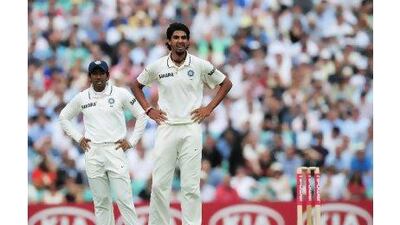When you've been terrible, you really don't want to read about it. An article by Andrew Miller, Cricinfo's UK editor, has sent Indian cricket fans into a tizzy.
Titled "India have become a laughing stock", it says (among other things): "Something dramatic has come to pass in the course of the past four fixtures, and though the BCCI [Board of Control for Cricket in India] can ignore if it chooses, it would be foolish to do so.
"Indian cricket has become the laughing stock of the world game, and while that might not seem to matter to a board that generates 70 per cent of the sport's global income and has in its locker room the World Cup trophy, no less, ridicule tends to be a corrosive disease."
You can understand where he is coming from. There is no disgrace in losing, or in being outplayed. That has happened to better teams than India, including Steve Waugh's legendary Australians against Sourav Ganguly's men in 2001.
What really rankles with those who expected so much from this series is India's failure to turn up in all but name.
Take out the magnificent defiance of Rahul Dravid with the bat and Praveen Kumar's lionhearted effort with the ball, and there is not a crumb of comfort in sight.
And it is not just the English who have been critical about India's meek abdication of the No 1 Test ranking.
In a scathing article for Tehelka, the Indian weekly news magazine, Suresh Menon, one of India's senior cricket writers, takes aim at the frankly pathetic excuses trotted out by Krishnamachari Srikkanth, India's chairman of selectors, who reckoned that "nobody is to be blamed".
"As brand ambassador of the Chennai Super Kings, which is owned by the BCCI secretary N Srinivasan and is led by the Indian captain, Srikkanth is entitled to his opinion," wrote Menon.
"Of course, no one is to be blamed. Just as no one is to be blamed for the Great Train Robbery or the galloping price of petrol or the assassination of Abraham Lincoln."
There were also a few ruffled feathers after the Edgbaston Test in Birmingham when Michael Atherton asked MS Dhoni whether India had cherished the No 1 ranking enough.
Given India's inadequate preparation for a series of this magnitude, it was a fair query. But it was directed at the wrong person. You do not blame the mannequin for poorly designed clothes.
If anyone has not cherished Test cricket, it is the succession of administrators who have presided over a period of unimagined financial prosperity.
There is a perception that India is obsessed with one-day cricket to the exclusion of all else. The numbers do not really bear that out.
In the past decade, Australia (114 games) have played more 50-over games on home soil than India (105). England, who have hosted 96 one-dayers, are not far behind.
Where the BCCI has really let down the sport is by treating the Test game as an afterthought.
In the same period, England have hosted 70 Tests, and Australia 60. The figure for India is a paltry 47. Even Sri Lanka (49) have played more.
Of course, administrators such as Srinivasan, Shashank Manohar and Sharad Pawar have merely carried on an appalling tradition.
In the 1990s, India hosted just 30 matches. The previous decade saw only 42, although that was partly down to the reluctance of several teams to tour, citing everything from the heat and dust to Delhi belly.
India climbed to the top of the rankings primarily because the team contained some of the best players ever to wear the national cap.
The achievement was not the result of an especially robust domestic structure or any long-term plan on the part of the cricket board.
Forget that India does not have a defined home season, or that Twenty20 competitions have eaten into what used to be the off season.
Consider the fact the world's richest board has not even bothered to have a major Test series as the centrepiece of its home season.
Lord's traditionally hosts the first Test of a big summer series, while the Melbourne Cricket Ground is synonymous with the Boxing Day game.
The shame of it is that India did once have such a game.
Until 1988, when a bespectacled and hair band-wearing Narendra Hirwani ambushed the mighty West Indies on his debut, Chennai hosted nine games that started around Pongal, the harvest festival in mid-January.
In more than two decades since, there has been nothing. One Test in 2005 against Sri Lanka was almost completely washed out, farcically scheduled in the middle of the rainy season.
It is not just about creating tradition though. Watching a Test match at most English, Australian or South African grounds is a pleasure, an ideal opportunity for a relaxed family day out.
At venues such as The Gabba in Brisbane and Trent Bridge in Nottingham, your ticket gives you a free bus ride to the ground. At venues such as Nagpur, where the stadium is miles from the city, even a rickshaw ride can cost you upwards of 200 rupees (Dh16).
The Dalai Lama once said: "Remember that not getting what you want is sometimes a wonderful stroke of luck."
Indian cricket can either learn from this debacle and strengthen Test cricket's roots back home, or it can go the way of summer's swallows.

